
Image credit: Vertico
While 3D printing has been with us for some time now – its roots are embedded in a technique known as ‘stereolithography’ developed in 1984 by Chuck Hall – its real potential has only come into fruition over the past few years.
Advanced applications of 3D printing methods now influence a wide range of industries such as fashion, food, construction, prosthetics and even bioengineering for functional human organs. The exponential growth of 3D printing and the impact it has on industry and everyday life offers a pioneering outlook into the future of the way we live.
What’s more is that 3D printing could in fact print the future, that is to say, the spaces in which we live and inhabit could be completely constructed using this technology. The Netherlands-based 3D printing company Vertico has recently collaborated with the University of Ghent to generate a concrete bridge using a 3D printer. Their technique builds structures layer-by-layer using a concrete mixture made for purpose. Vertico believes that this would offer greater freedom of form in construction as there is no need for expensive molds.
This bridge showcases the range of possibilities that 3D concrete printing offers. At Vertico, we believe that this technology is the key to unlocking material optimization in structures, reducing CO2 emissions whilst simultaneously increasing productivity in the construction industry.
Volker Ruitinga, The Founder of Vertico
This is not the first time a Dutch initiative has come forward with proposals that could revolutionize the construction industry. Eindhoven based construction company Van Wijen conceived Project Milestone as a way of overcoming a shortage of skilled bricklayers in the Netherlands as well as providing sustainable, affordable housing that could be quickly and easily constructed.
What 3D printing does in terms of improving the construction industry goes beyond the scope of building easy and unconventional structures as it could potentially help increase automation and also reduce carbon emissions. The construction industry is responsible for producing 23% of global CO2 emissions and significantly trails other production-based industries in how it tackles this ever-growing global concern. Methods, such as the ones developed by Vertico and Van Wijen, would also cut costs and offer further environmental benefits as less cement is which in turn causes less damage and reduces waste.
"The desire for material & CO2 reduction, automation & productivity trends and cost-effective production requirements make 3D concrete printing an innovation with a lot potential," stated Vertico. The process of making the bridge reduced the material required by up to 60% which further reveals the potential that 3D printing in construction techniques offers. It could be a key factor in how the industry combats contributing factors to the current climate emergency and future climate change. In fact, the sheer size of cement production and the concrete industry is so big that if it were a country it would the third largest emitter of CO2 behind China and the US.
Vertico and the University of Ghent, along with other industry innovators, are committed to changing the landscape of the construction industry in terms of developing state-of-the-art techniques that help recast the potential of fabrication as well as reducing environmental impact. Looking at using their 3D printing method for biomimicry techniques, Vertico is leading the way in this area.
Biological materials have very distinct structural properties, which foster increased resistance to damage and stress. Thus, inspired by nature to produce the optimal and structurally complex shapes, shows great examples of efficient material use.
“Structural optimization tools are now being used more and more to minimize material use and thus CO2. This optimization often results in very organic shapes, which is not surprising as in nature evolution optimizes material use. These unique forms and organic shapes, or biomimicry, are very costly to build with traditional techniques”, Vertico continues.
New techniques that help reduce the use of concrete in the construction of structures such as bridges, houses and other buildings are now in high demand. This is why 3D concrete printing is being celebrated throughout the industry today as it could enable significant reductions of carbon emissions as well as providing construction with a future that is free to produce efficient, unique shapes and forms at a fraction of traditional costs.
Thus, from the heart of urban infrastructures to that of humans, the power of the imagination to remake the world could be set free in the form of 3D printed technologies.
Disclaimer: The views expressed here are those of the author expressed in their private capacity and do not necessarily represent the views of AZoM.com Limited T/A AZoNetwork the owner and operator of this website. This disclaimer forms part of the Terms and conditions of use of this website.